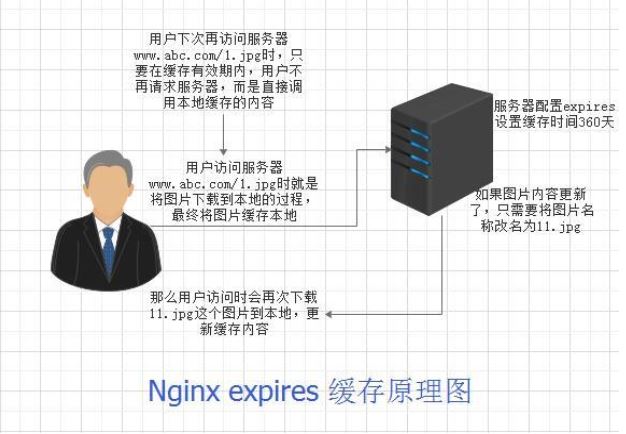How to optimize the configuration of Nginx service
1. expires cache module

For specific configuration, please refer to the official document
[root@cairui conf]# cat nginx.conf | egrep -v "#|^$"
user nginx;
worker_processes 1;
events {
worker_connections 1024;
}
http {
include mime.types;
default_type application/octet-stream;
sendfile on;
keepalive_timeout 65;
server {
listen 80;
server_name localhost;
location / {
root html;
index index.html index.htm;
}
location ~ .*\.(gif|jpg|jpeg|png|bmp|swf|js|html|htm|css)$ {
log_not_found off;
expires 7d ;
access_log off;
proxy_store on;
proxy_store_access user:rw group:rw all:rw;
}
error_page 500 502 503 504 /50x.html;
location = /50x.html {
root html;
}
}
}
[root@cairui conf]# curl -i http://120.25.255.87/1.jpg
http/1.1 200 ok
server: nginx/1.13.9
date: mon, 05 mar 2018 04:08:41 gmt
content-type: image/jpeg
content-length: 48561
last-modified: wed, 29 nov 2017 08:16:39 gmt
connection: keep-alive
etag: "5a1e6ce7-bdb1"
expires: mon, 12 mar 2018 04:08:41 gmt
cache-control: max-age=604800
accept-ranges: bytes2. nginx compression module (gzip)

Configure the compression module
[root@localhost vhost]# vi www.vhosts
server {
listen 8001;
server_name 192.168.1.3;
location / {
root /web/www;
index index.html index.htm;
access_log /application/nginx/log/access_www.log commonlog;
}
location ~ .*\.(gif|jpg|jpge|png|bmp|swf)$
{
expires 3560d;
root /web/www;
}
location ~ .*\.(js|css)?$
{
expires 30d;
root /web/www;
}
gzip on; #开启压缩功能
gzip_min_length 1k; #设置允许压缩页面的最小字节数
gzip_buffers 4 16k;
gzip_http_version 1.0;
gzip_comp_level 2;
gzip_types text/plain application/x-javascript text/css application/xml;
gzip_vary on;
}Check the syntax and restart the service
[root@localhost vhost]# /application/nginx/sbin/nginx -t nginx: the configuration file /application/nginx-1.10.1/conf/nginx.conf syntax is ok nginx: configuration file /application/nginx-1.10.1/conf/nginx.conf test is successful [root@localhost vhost]# /application/nginx/sbin/nginx -s reload [root@localhost vhost]# cd /web/www/ [root@localhost www]# ll total 12 -rw-r--r--. 1 root root 20 sep 26 07:00 index.html -rw-r--r--. 1 root root 5798 sep 19 06:46 mysql.jpg [root@localhost www]# rz rz waiting to receive. starting zmodem transfer. press ctrl+c to cancel. transferring 1.js... 100% 42 kb 42 kb/s 00:00:01 0 errors ?[root@localhost www]# ll total 56 -rw-r--r--. 1 root root 43978 sep 27 05:06 1.js -rw-r--r--. 1 root root 20 sep 26 07:00 index.html -rw-r--r--. 1 root root 5798 sep 19 06:46 mysql.jpg 客户端访问 http://192.168.1.3:8001/1.js [root@localhost www]# curl -i http://192.168.1.3:8001/1.js http/1.1 200 ok server: nginx/1.10.1 date: tue, 27 sep 2016 04:44:08 gmt content-type: application/javascript content-length: 43978 last-modified: tue, 27 sep 2016 02:06:23 gmt connection: keep-alive etag: "57e9d41f-abca" expires: thu, 27 oct 2016 04:44:08 gmt cache-control: max-age=2592000 accept-ranges: bytes
The above is the detailed content of How to optimize the configuration of Nginx service. For more information, please follow other related articles on the PHP Chinese website!

Hot AI Tools

Undresser.AI Undress
AI-powered app for creating realistic nude photos

AI Clothes Remover
Online AI tool for removing clothes from photos.

Undress AI Tool
Undress images for free

Clothoff.io
AI clothes remover

Video Face Swap
Swap faces in any video effortlessly with our completely free AI face swap tool!

Hot Article

Hot Tools

Notepad++7.3.1
Easy-to-use and free code editor

SublimeText3 Chinese version
Chinese version, very easy to use

Zend Studio 13.0.1
Powerful PHP integrated development environment

Dreamweaver CS6
Visual web development tools

SublimeText3 Mac version
God-level code editing software (SublimeText3)

Hot Topics
 1390
1390
 52
52
 How to check nginx version
Apr 14, 2025 am 11:57 AM
How to check nginx version
Apr 14, 2025 am 11:57 AM
The methods that can query the Nginx version are: use the nginx -v command; view the version directive in the nginx.conf file; open the Nginx error page and view the page title.
 How to configure cloud server domain name in nginx
Apr 14, 2025 pm 12:18 PM
How to configure cloud server domain name in nginx
Apr 14, 2025 pm 12:18 PM
How to configure an Nginx domain name on a cloud server: Create an A record pointing to the public IP address of the cloud server. Add virtual host blocks in the Nginx configuration file, specifying the listening port, domain name, and website root directory. Restart Nginx to apply the changes. Access the domain name test configuration. Other notes: Install the SSL certificate to enable HTTPS, ensure that the firewall allows port 80 traffic, and wait for DNS resolution to take effect.
 How to start nginx server
Apr 14, 2025 pm 12:27 PM
How to start nginx server
Apr 14, 2025 pm 12:27 PM
Starting an Nginx server requires different steps according to different operating systems: Linux/Unix system: Install the Nginx package (for example, using apt-get or yum). Use systemctl to start an Nginx service (for example, sudo systemctl start nginx). Windows system: Download and install Windows binary files. Start Nginx using the nginx.exe executable (for example, nginx.exe -c conf\nginx.conf). No matter which operating system you use, you can access the server IP
 How to check the name of the docker container
Apr 15, 2025 pm 12:21 PM
How to check the name of the docker container
Apr 15, 2025 pm 12:21 PM
You can query the Docker container name by following the steps: List all containers (docker ps). Filter the container list (using the grep command). Gets the container name (located in the "NAMES" column).
 How to check whether nginx is started
Apr 14, 2025 pm 01:03 PM
How to check whether nginx is started
Apr 14, 2025 pm 01:03 PM
How to confirm whether Nginx is started: 1. Use the command line: systemctl status nginx (Linux/Unix), netstat -ano | findstr 80 (Windows); 2. Check whether port 80 is open; 3. Check the Nginx startup message in the system log; 4. Use third-party tools, such as Nagios, Zabbix, and Icinga.
 How to configure nginx in Windows
Apr 14, 2025 pm 12:57 PM
How to configure nginx in Windows
Apr 14, 2025 pm 12:57 PM
How to configure Nginx in Windows? Install Nginx and create a virtual host configuration. Modify the main configuration file and include the virtual host configuration. Start or reload Nginx. Test the configuration and view the website. Selectively enable SSL and configure SSL certificates. Selectively set the firewall to allow port 80 and 443 traffic.
 How to deploy jar program in nginx
Apr 14, 2025 pm 12:09 PM
How to deploy jar program in nginx
Apr 14, 2025 pm 12:09 PM
To deploy a JAR program on Nginx, seven steps need to be followed: 1) Install JRE, 2) Install Nginx, 3) Configure Nginx, 4) Deploy JAR, 5) Grant execution permissions, 6) Restart Nginx, 7) Verify deployment.
 How to run nginx apache
Apr 14, 2025 pm 12:33 PM
How to run nginx apache
Apr 14, 2025 pm 12:33 PM
To get Nginx to run Apache, you need to: 1. Install Nginx and Apache; 2. Configure the Nginx agent; 3. Start Nginx and Apache; 4. Test the configuration to ensure that you can see Apache content after accessing the domain name. In addition, you need to pay attention to other matters such as port number matching, virtual host configuration, and SSL/TLS settings.




